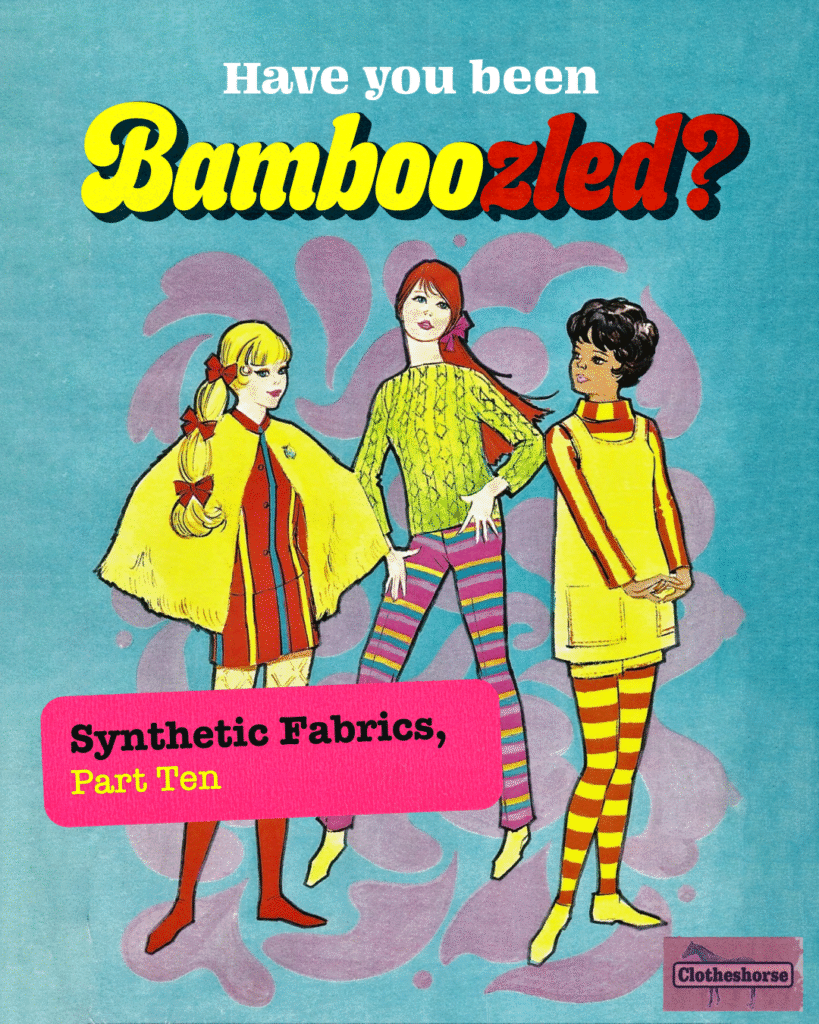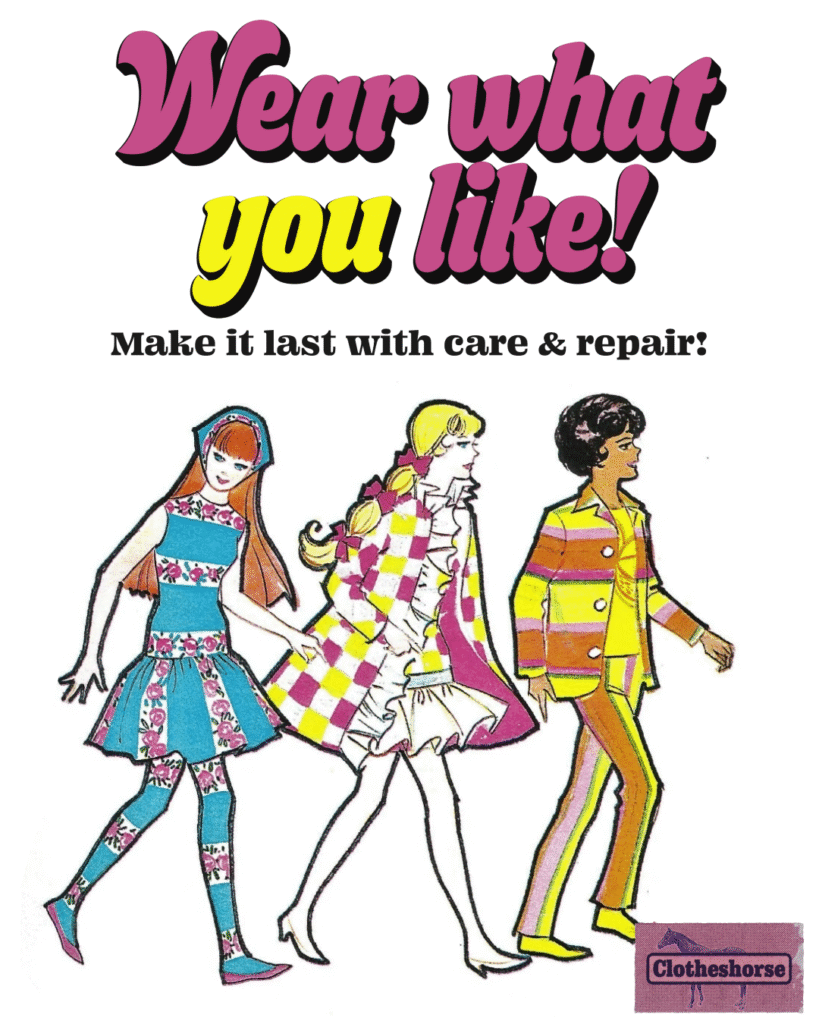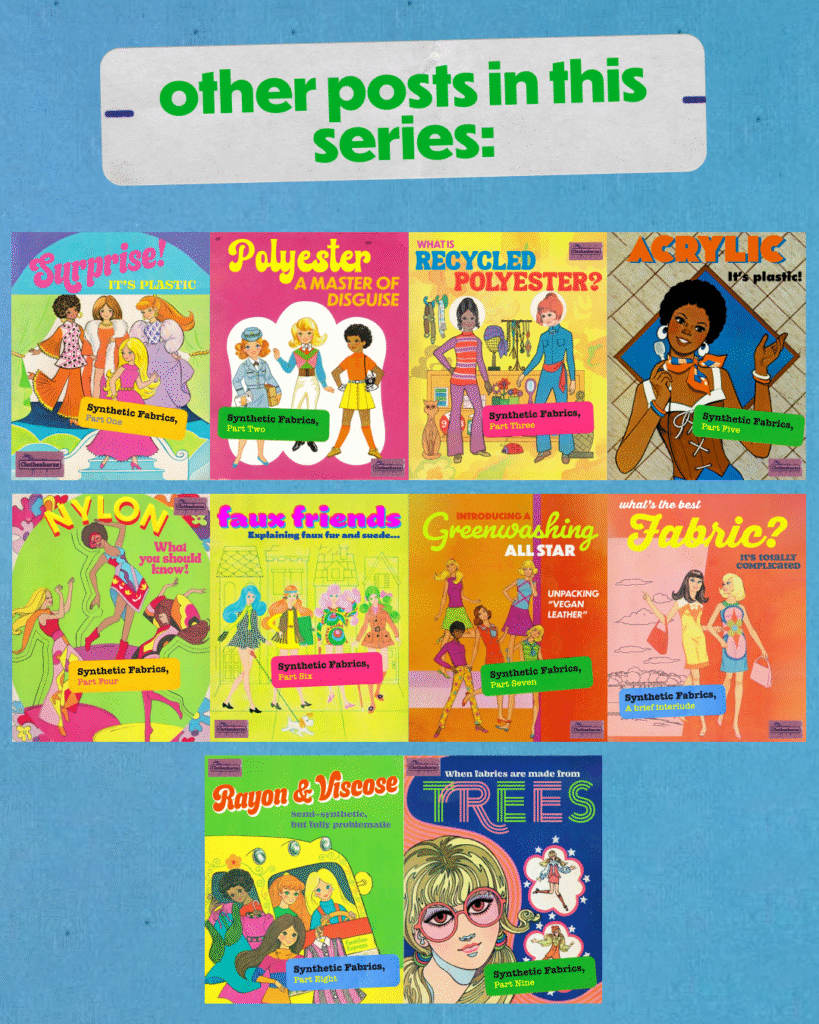
These are NOT the goals: Making you feel guilty. Getting you to throw out all of your clothes. Filling you with a sense of panic and/or despair.
This is the goal: educating you about all of these fabrics, how they are made, what that impact is, and how to care for them properly.
Yes, knowledge can be overwhelming and disappointing…but it’s also EMPOWERING! Every fabric has a catch. And it’s important for us to know the “catch” to those fabrics so we can make the best decisions. And furthermore, it feels good in a surprising way to uncover more ways in which retailers and brands have been misleading us!
Many of these fabrics have been used as a means of greenwashing. The goal of greenwashing? To get us to continue over shopping and over consuming by misleading us into believing that these fabrics are either “good” for the planet (and therefore we should buy more if we want to save the planet) or have zero impact on the planet (obviously not true). Greenwashing sells us the illusion that we can still buy lots of clothes that we will barely wear. Greenwashing tells us “go ahead…get a new dress for every party or buy into every single trend.” When your entire business model depends on overconsumption, you’re going to do everything you can to trick people into buying more.
Hi, my name is Amanda and I have been bamboo-zled. Meaning: I have fallen for some claims about bamboo fabric that were just too good to be true! Bamboo actually has a lot of sensory qualities that I appreciate, but it is at the center of a lot of greenwashing.
THERE IS NO MIRACLE FABRIC THAT ALLOWS US TO CONTINUE TO OVERCONSUME CLOTHING/TEXTILES…especially to the level that the fast fashion model requires. Bamboo is great for greenwashing because we can see that it grows super fast. It’s super hardy and uses little water. The house we rented when we lived in Austin had a mini bamboo forest in the backyard and it grew so fast! But I can also see that turning bamboo into fabric isn’t simple. And my brain can’t even begin to understand just how much bamboo would be required to make lots of clothes for lots of people.
Bamboo itself has a lot of amazing characteristics:
It is the fastest growing plant on Earth
It requires little cultivation, and it can be grown without pesticides and fertilizers.
It may trap 4X more carbon dioxide than hardwood trees (but other research indicates it may not).
It may produce 35% more oxygen than hardwood trees.
In fact, in 2013, the FTC cracked down on 78 retailers/brands for their egregious greenwashing claims around bamboo, including Sears, Macy’s, Amazon, and Bed Bath and Beyond.
What were they doing? Claiming that items were “sustainable” and “eco-friendly” because they contained bamboo, but they neglected to mention that these items were actually made from bamboo rayon. To understand WHY this was greenwashing, you have to understand how bamboo is turned into fabric.
Bamboo is technically a type of grass, but we can all agree that it is not very soft. That’s why it is often used to make utensils and flooring! Turning this wood-like material into fabric is no easy feat. There is a lot of science involved!
There are two ways to turn bamboo into fabric: mechanically or chemically.
Next, the natural fibers of the bamboo are combed out mechanically and then spun into yarn.
This process is relatively low impact, and the final product has a nice linen feel. This is called bamboo linen.
Unfortunately very little bamboo fabric is created using this process because it is labor intensive and therefore, more expensive.
As I discussed in Part 8 of this series, semi-synthetic fabrics (also know as “man-made cellulosic” fabrics) are made from materials like wood pulp and bamboo, using some pretty intense chemicals and processes.
The most commonly used process for transforming bamboo is the “viscose method.”
This process is so harmful, it is an issue of environmental justice.
The fabric itself is drapey and breathable, but its impact is serious.
Do a casual internet search about the positive attributes of bamboo fabric, and you will likely encounter claims of antibacterial properties and UV resistance.
These are qualities that bamboo naturally has…before it is turned into fabric. Through the intense process of turning a very un-fabric like material into soft, wearable fabric…bamboo loses those properties. Testing has indicated that the fabric version of bamboo is neither anti-microbial nor UV resistant.
It’s complicated.
The mechanical way of creating bamboo fabric is relatively low impact.
However, the vast majority of bamboo textiles being sold right now are made with the “viscose method,” because it is so much cheaper.
There are closed loop systems (like the one created by Lenzing) that can minimize the chemical use in the viscose process, but this process has not been widely adopted.
There is no miracle fabric that allows us to continue to overconsume clothing without repercussion. Buying lots of new clothes, barely wearing them, then buying some more…it can never be sustainable.
The demand for bamboo has more than doubled since 2000. Keeping up with this demand has lead to deforestation, as trees have been cut down in order to free up land for growing bamboo.
There’s just not enough transparency in the supply chain. There is no proof that bamboo is being grown sustainably or that it is being harvested ethically, without forced labor or exploitive working conditions.
Follow the instructions on the care label. If the label is missing:
Wash in cold on the gentle cycle.
Air dry (if possible) or tumble dry on the lowest setting.
Never use bleach or fabric softener.
Knitted bamboo garments should be hand washed in cold water and laid flat to dry.
More structured items like blazers, lined pants/dresses, and jackets should be dry cleaned.

Images are from the 1968 Barbie, Christie, & Stacey paper doll book.

The last thing I want to add here: odds are good that your favorite small business isn’t planning on buying an election, gutting the federal government, or blasting rockets into the atmosphere. So shop small when you can!
If you want to share your opinion/additional thoughts on the subjects we cover in each episode, feel free to email, whether it’s a typed out message or an audio recording: [email protected]
Slow Fashion Academy is a size-inclusive sewing and patternmaking studio based in Philadelphia, Pennsylvania. Designer and fashion professor Ruby Gertz teaches workshops for hobbyists and aspiring designers, so that anyone can learn the foundational skills of making, mending, and altering their own clothes. Ruby also provides professional design and patternmaking services to emerging slow fashion brands, and occasionally takes commissions for custom garments and costume pieces. She has also released several PDF sewing patterns for original designs under her brands Spokes & Stitches, and Starling Petite Plus. Check the schedule for upcoming workshops, download PDF sewing patterns, and learn about additional sewing and design services at www.slowfashion.academy.
Thumbprint is Detroit’s only fair trade marketplace, located in the historic Eastern Market. Our small business specializes in products handmade by empowered women in South Africa making a living wage creating things they love like hand painted candles and ceramics! We also carry a curated assortment of sustainable/natural locally made goods. Thumbprint is a great gift destination for both the special people in your life and for yourself! Browse our online store at thumbprintdetroit.com and find us on instagram @thumbprintdetroit.
Picnicwear: a slow fashion brand, ethically made by hand from vintage and deadstock materials – most notably, vintage towels! Founder, Dani, has worked in the industry as a fashion designer for over 10 years, but started Picnicwear in response to her dissatisfaction with the industry’s shortcomings. Picnicwear recently moved to rural North Carolina where all their clothing and accessories are now designed and cut, but the majority of their sewing is done by skilled garment workers in NYC. Their customers take comfort in knowing that all their sewists are paid well above NYC minimum wage. Picnicwear offers minimal waste and maximum authenticity: Future Vintage over future garbage.
Shift Clothing, out of beautiful Astoria, Oregon, with a focus on natural fibers, simple hardworking designs, and putting fat people first. Discover more at shiftwheeler.com
High Energy Vintage is a fun and funky vintage shop located in Somerville, MA, just a few minutes away from downtown Boston. They offer a highly curated selection of bright and colorful clothing and accessories from the 1940s-1990s for people of all genders. Husband-and-wife duo Wiley & Jessamy handpick each piece for quality and style, with a focus on pieces that transcend trends and will find a home in your closet for many years to come! In addition to clothing, the shop also features a large selection of vintage vinyl and old school video games. Find them on instagram @ highenergyvintage, online at highenergyvintage.com, and at markets in and around Boston.
St. Evens is an NYC-based vintage shop that is dedicated to bringing you those special pieces you’ll reach for again and again. More than just a store, St. Evens is dedicated to sharing the stories and history behind the garments. 10% of all sales are donated to a different charitable organization each month. New vintage is released every Thursday at wearStEvens.com, with previews of new pieces and more brought to you on Instagram at @wear_st.evens.
Deco Denim is a startup based out of San Francisco, selling clothing and accessories that are sustainable, gender fluid, size inclusive and high quality–made to last for years to come. Deco Denim is trying to change the way you think about buying clothes. Founder Sarah Mattes wants to empower people to ask important questions like, “Where was this made? Was this garment made ethically? Is this fabric made of plastic? Can this garment be upcycled and if not, can it be recycled?” Signup at decodenim.com to receive $20 off your first purchase. They promise not to spam you and send out no more than 3 emails a month, with 2 of them surrounding education or a personal note from the Founder. Find them on Instagram as @deco.denim.
The Pewter Thimble Is there a little bit of Italy in your soul? Are you an enthusiast of pre-loved decor and accessories? Bring vintage Italian style — and history — into your space with The Pewter Thimble (@thepewterthimble). We source useful and beautiful things, and mend them where needed. We also find gorgeous illustrations, and make them print-worthy. Tarot cards, tea towels and handpicked treasures, available to you from the comfort of your own home. Responsibly sourced from across Rome, lovingly renewed by fairly paid artists and artisans, with something for every budget. Discover more at thepewterthimble.com
Blank Cass, or Blanket Coats by Cass, is focused on restoring, renewing, and reviving the history held within vintage and heirloom textiles. By embodying and transferring the love, craft, and energy that is original to each vintage textile into a new garment, I hope we can reteach ourselves to care for and mend what we have and make it last. Blank Cass lives on Instagram @blank_cass and a website will be launched soon at blankcass.com.
Vagabond Vintage DTLV is a vintage clothing, accessories & decor reselling business based in Downtown Las Vegas. Not only do we sell in Las Vegas, but we are also located throughout resale markets in San Francisco as well as at a curated boutique called Lux and Ivy located in Indianapolis, Indiana. Jessica, the founder & owner of Vagabond Vintage DTLV, recently opened the first IRL location located in the Arts District of Downtown Las Vegas on August 5th. The shop has a strong emphasis on 60s & 70s garments, single stitch tee shirts & dreamy loungewear. Follow them on instagram, @vagabondvintage.dtlv and keep an eye out for their website coming fall of 2022.
Country Feedback is a mom & pop record shop in Tarboro, North Carolina. They specialize in used rock, country, and soul and offer affordable vintage clothing and housewares. Do you have used records you want to sell? Country Feedback wants to buy them! Find us on Instagram @countryfeedbackvintageandvinyl or head downeast and visit our brick and mortar. All are welcome at this inclusive and family-friendly record shop in the country!
Located in Whistler, Canada, Velvet Underground is a “velvet jungle” full of vintage and second-hand clothes, plants, a vegan cafe and lots of rad products from other small sustainable businesses. Our mission is to create a brand and community dedicated to promoting self-expression, as well as educating and inspiring a more sustainable and conscious lifestyle both for the people and the planet. Find us on Instagram @shop_velvetunderground or online at www.shopvelvetunderground.com
Selina Sanders, a social impact brand that specializes in up-cycled clothing, using only reclaimed, vintage or thrifted materials: from tea towels, linens, blankets and quilts. Sustainably crafted in Los Angeles, each piece is designed to last in one’s closet for generations to come. Maximum Style; Minimal Carbon Footprint.
Salt Hats: purveyors of truly sustainable hats. Hand blocked, sewn and embellished in Detroit, Michigan.
Republica Unicornia Yarns: Hand-Dyed Yarn and notions for the color-obsessed. Made with love and some swearing in fabulous Atlanta, Georgia by Head Yarn Wench Kathleen. Get ready for rainbows with a side of Giving A Damn! Republica Unicornia is all about making your own magic using small-batch, responsibly sourced, hand-dyed yarns and thoughtfully made notions. Slow fashion all the way down and discover the joy of creating your very own beautiful hand knit, crocheted, or woven pieces. Find us on Instagram @republica_unicornia_yarns and at www.republicaunicornia.com.
Cute Little Ruin is an online shop dedicated to providing quality vintage and secondhand clothing, vinyl, and home items in a wide range of styles and price points. If it’s ethical and legal, we try to find a new home for it! Vintage style with progressive values. Find us on Instagram at @CuteLittleRuin.